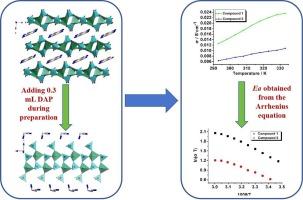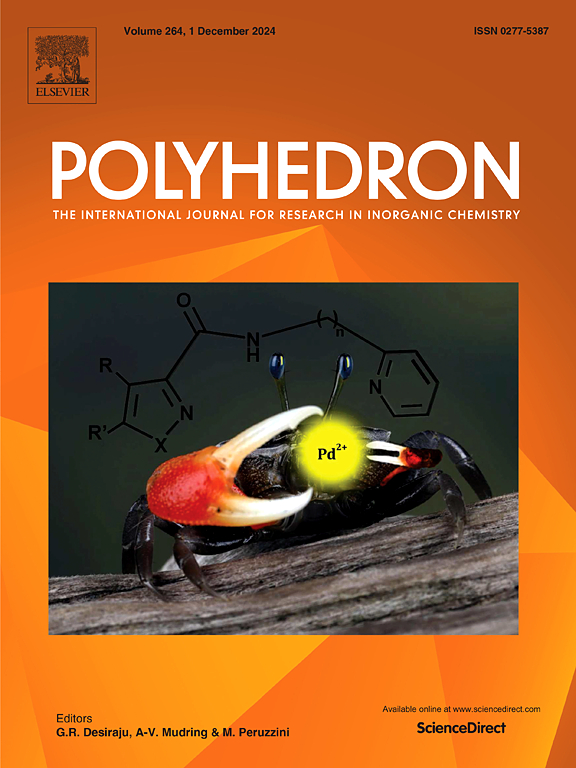A 2D open framework zinc phosphate and its high proton conductance properties at medium and low temperature
IF 2.4
3区 化学
Q2 CHEMISTRY, INORGANIC & NUCLEAR
引用次数: 0
Abstract
A 2D open-framework zinc phosphate [C3N2H12][Zn2(HPO4)3] (1) was synthesized by solvothermal method. The inorganic anion layer is constructed from Zn2P2O12 cluster units and the interlayer spaces are filled by the diprotonated DAP molecules. The resultant compound had high purity and thermal stability by PXRD and TG analysis. This compound exhibited strongly temperature and humidity dependent proton conductivity, and its highest proton conductivity achieves 2.36 × 10−2 S.cm−1 at 100 %RH and 333 K. Moreover, the important effect of the dense hydrogen bond network in elevating the proton conductivity was explored through comparing the structure and proton conduction behavior between 1 and [C3N2H12][Zn(HPO4)2] (2), which synthesized via the same hydrothermal reaction process, and only a slight difference in the amount of DAP.

二维开放框架磷酸锌及其在中低温条件下的高质子传导特性
通过溶热法合成了二维开放框架磷酸锌[C3N2H12][Zn2(HPO4)3] (1)。无机阴离子层由 Zn2P2O12 团簇单元构成,层间空隙由二质子化 DAP 分子填充。通过 PXRD 和 TG 分析,得到的化合物具有高纯度和热稳定性。此外,通过比较 1 与[C3N2H12][Zn(HPO4)2] (2)的结构和质子传导行为,探索了致密氢键网络在提高质子传导性方面的重要作用;[C3N2H12][Zn(HPO4)2] (2)是通过相同的水热反应过程合成的,只是 DAP 的用量略有不同。
本文章由计算机程序翻译,如有差异,请以英文原文为准。
求助全文
约1分钟内获得全文
求助全文
来源期刊

Polyhedron
化学-晶体学
CiteScore
4.90
自引率
7.70%
发文量
515
审稿时长
2 months
期刊介绍:
Polyhedron publishes original, fundamental, experimental and theoretical work of the highest quality in all the major areas of inorganic chemistry. This includes synthetic chemistry, coordination chemistry, organometallic chemistry, bioinorganic chemistry, and solid-state and materials chemistry.
Papers should be significant pieces of work, and all new compounds must be appropriately characterized. The inclusion of single-crystal X-ray structural data is strongly encouraged, but papers reporting only the X-ray structure determination of a single compound will usually not be considered. Papers on solid-state or materials chemistry will be expected to have a significant molecular chemistry component (such as the synthesis and characterization of the molecular precursors and/or a systematic study of the use of different precursors or reaction conditions) or demonstrate a cutting-edge application (for example inorganic materials for energy applications). Papers dealing only with stability constants are not considered.
 求助内容:
求助内容: 应助结果提醒方式:
应助结果提醒方式:


